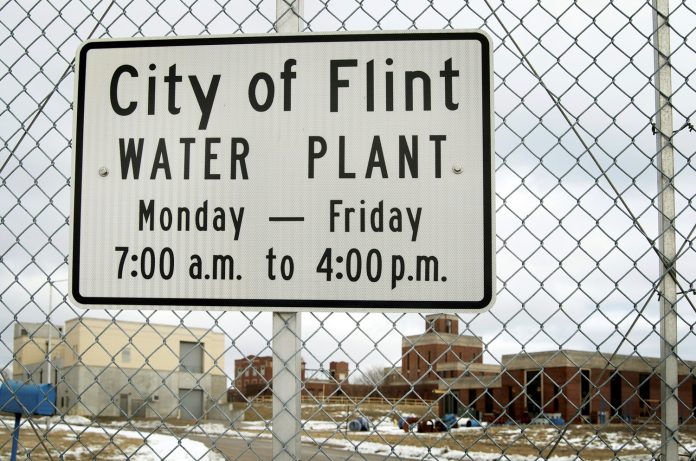The lead poisoning of residents through the municipal water system in Flint, in Michigan state in the United States, aroused shock, anger and disbelief but what are the lessons to avoid this happening again, not only in the world’s largest economy but in more vulnerable countries? A global panel of water professionals offer a frank insight into what went wrong
1. Keep amateurs out of professional water decisions
Many focused on the physical chain reaction that arose from switching from one source of water to another (see Timeline) but that misses the underlying story, according to Glen Daigger at One Water Solutions:
“What you can see is that, although technical issues are involved, the events that have occurred in Flint do not have their origin in technical issues. Rather, they originate in poor decision-making, and decision-making led by others not water professionals. A competent water professional would have concluded that appropriate levels of corrosion inhibitors must be added to the Flint water supply. But, this was not done with the change in water supply, apparently to save money. Of course, the economic consequences to the city outweigh any cost savings by a wide, wide margin. The failure here from the perspective of the water profession was for competent water professionals to remain engaged and positioned to provide relevant advice. What occurred was that a decision with potentially dramatic public health and economic consequences was made solely on the basis of short-term financial considerations. That is the fundamental failure here.”
2. Water demands uniform standards
Oddly, the US Safe Water Drinking Act regulates lead differently. Unlike other contaminants, it has no legal maximum contaminant level (MCL). The ‘action level’ is worse than World Health Organisation standards, and even then can be exceeded at 10 percent of customers’ homes without a utility having to take remedial action. You can’t enforce what isn’t regulated, according to Maura Allaire, a postdoc researcher at Columbia University in the US:
“Enforcement responsibilities for drinking water quality largely reside with the states. The Environmental Protection Agency (EPA) can take action when a state is unable to, or requests it. Yet, as the Flint crisis has illustrated, states might delay or avoid requesting an EPA enforcement action. If a serious, health-based violation is known, the EPA should be able to step in when the state-level response is inadequate or slow. This could protect low-income communities vulnerable to violations since their public water suppliers tend to struggle to finance past debt and operations and management costs. Customers should be informed of violations in an expedient way via SMS alerts when public health is at risk.”
Timeline: Chronicle of a tragedy foretold
1980-2012: the economically poor population of majority-black Flint, Michigan contracts 50 percent, shrinking the base of accounts who pay for water services.
2011: fiscally bankrupt, Flint is taken into state receivership, where a revolving number of ‘emergency managers’ explore options to cut costs any way they can.
14 February 2012: internal audits estimate that Flint leaks more than 30 percent of its water.
10 May 2012: against a 25 percent rate increase, angry Flint residents stage protests at City Hall.
2013: the city population drops below 100,000 for the first time since 1920.
25 April 2014: as an austerity measure, the city switches its water source from the nearby Detroit municipal system, and starts to draw directly from the Flint River, which is fed by agricultural, industrial and urban runoff.
Within months: residents began to complain about the water’s taste, colour, and smell.
January 2015: Detroit offers to reconnect its water at no fee; Flint’s manager declines.
3 March 2015: one home found 397 parts per billion in its supply. The US Environmental Protection Agency is expected to intervene if lead levels in tap water reach 15 parts per billion (WHO standard is 10 ppm). An EPA official tells Flint’s mayor that “it would be premature to draw any conclusions”.
2 September 2015: municipal water quality expert Professor Marc Edwards reports that corrosion from the Flint River water was causing lead to leach into the water system. The Michigan Department of Environmental Quality challenges his conclusions.
5 January 2016: Governor Rick Snyder declares a state of emergency for the county and city.
3. Blame won’t help, resignations may worsen matters
In the wake of a disaster, tribal loyalties cloud logic. Republicans accused the federal Environmental Protection Agency of incompetence, and demanded that EPA head Gina McCarthy step down. Democrats counter that the State must take responsibility for the failure that occurred on its watch, under its jurisdiction and policies, and called on Governor Rick Snyder to resign. When the Flint Water Advisory Task Force concluded that “the primary responsibility for what happened in Flint rests with the Michigan Department of Environmental Quality,” its director Dan Wyant, duly resigned. None of that will rebuild trust, says Paul Reiter, president, Reiter IWS and visiting professor at Xian University, China:
“It’s not just the EPA or the Governor [who is] to blame. Water systems are really complicated entities, often the product of hundreds of years of incremental changes. So it’s typically a multitude of actors from federal to local health officials in the mayor’s office, and so if something bad happens there are plenty of figures to take responsibility. There was one element by the governor, but then also a lot of rotating administrators with no long-term stake in the game, all sharing responsibility. It may take a decade or more for the city of Flint to rebuild trust, but accountability won’t happen by forcing the resignation of a few individuals. There’s gradual accretion so whenever you try to take a bold action, whatever your motivation, it’s really playing with fire and you have to be conservative, and risk averse. And in Flint, they weren’t.”
4. Short-termism risks both efficiency and equity
Water managers used to be insulated from the urgency of outside demands–quarterly earnings, frequent elections, new competition– that shorten the planning horizons of leaders in other sectors. That freedom is diminishing, says Thomas Van Waeyenberge at AquaFed:

“The global lesson from Flint is that the cost of neglecting water services is extremely high, both in money and in human terms. Water services are crucial to organised and fair societies. They require more attention than they are given in many places today. They need long-term political commitment and suffer when short-termism and polemics come into play. They need competent and professional operators to build, run and maintain them and they fail when skills and resources are not available. Balancing cost of service and price to users is a difficult equation that must be resolved. Efficiency and equity must be considered together. Efficiency to deliver the quality and reliability needed, to minimise losses and to optimise revenues. Equity to ensure those who can pay do and then those who can’t pay are supported.”
5. Lead’s toxic legacy: examine water, land, and buildings
The focus on Flint’s pipes risks obscuring or conflating lead risks from other sources according to Maura Allaire, a postdoctoral research scientist at Columbia University:

“Drinking water is not the only pathway. Lead paint remains widespread in older homes, especially in lower-income communities. A colleague working for the CDC [Center for Disease Control and Prevention] in Flint has remarked on the sub-standard housing in Flint and how elevated lead levels in children was likely an issue before the water crisis received national attention. Only focusing on water treatment will not solve the problem of lead exposure. Lead levels in some schools were over 30 times the national action level. As children face the gravest risks from exposure, testing at schools should be mandatory.”
6. Distrust leads to babies bathed in bottled water
If tap water is too contaminated to drink, do you shower with your mouth closed? Wash coffee mugs with it? Government scientists say the leadtainted water is safe to bathe in. No one believes them. At the front line of adaptive behaviour is Joshua Newton, a water consultant on governance and stakeholder engagement, volunteering with the Red Cross to distribute bottled water:
“Bottled water and filtered tap water meet most of the daily needs of the residents of Flint. What varies is the degree to which they trust using filtered tap water for drinking and cooking and/or are willing to take the risk of using unfiltered water for uses such as bathing and cleaning. Some households use one case a week and others are using upwards of 25-30 cases of bottled water per week, primarily for bathing, because they don’t want to risk showering with Flint’s water, especially in the case of children, or take the time (or don’t trust) using filtered tap water as the water comes out very slowly. It is faster to empty two cases of half-litre bottles of water, and then heat, if that is imaginable.”
7. It’s the underlying economy, stupid
The trouble began in Flint because of pressure to bring costs and proceeds into balance. A shrinking customer base was reducing income. Political pushback ruled out plans to boost rates per unit of water. Unable or unwilling to increase revenues, the administrators chose to cut costs and dip into the river. Those drivers aren’t unique to Flint, says Kenneth Persson, Professor at Forskningschef University, Lund, Sweden:
“The state administration forced economic management on the water and sanitation service of Flint. Economy was the sole objective for supply, with quality neglected. If water supply and sanitation is only a matter of profit, this will happen in many other towns in the US. A parallel focus on water quality is essential. Where were the voices of the Flint water professionals?”
8. Ensure consistency for water sampling
Although water quality standards are set at the national level, sampling protocols vary across states. Failure to detect quality violations can result from an inconsistent sample, says Allaire:
“Lead, total coliform, and other contaminants are based on a percentage of samples that exceed a certain concentration. Thus, violations could fail to be detected if repeated samples are taken. Lead testing could fail to detect elevated levels if dwellings likely to have high concentrations are avoided or discarded from final estimates. To reduce the chance that public water suppliers miss water quality issues, more specific protocols for sampling can limit over-sampling and better enforce ‘first draw’ sampling for lead and copper. Also, consider random sampling of tap water quality by regional EPA offices.”
9. Redundancy grows expensive, but essential, with age
As managers, water professionals are pushed to build efficiency into their systems: eliminate duplication, reduce labour, streamline efforts, accelerate decision-making, and trim fat. But ruthless efficiency can backfire, says Wolfgang Rauch, of the University of Innsbruck, Austria:

“Traditional water supply systems have redundancy on several levels. There is the ressurised pipe system itself, but also supervisory and emergency protocols. Neglect of the system due to economic constraints erodes the redundancy of the system. In the case of Flint, the institutional security system was not able to compensate the initial human error. The water supply system in Flint had been neglected over time and maintenance, monitoring and emergency protocols were insufficient. Consequently the system became vulnerable, which was not detected until the change of water source led to a stress to the system. And while top quality water infrastructure would have coped with the problem–because the lead pipes would have been replaced already or high-frequency monitoring installed–this system collapsed on several levels: technical, managerial and also with respect to crisis management. We need to be aware that security and quality of the water supply come at a certain price. The more redundancy we want to have in a system, the more expensive it becomes. If we want to restore trust in the water supply system, we need to restore the quality of the system itself–but we also need to tell the public that they have to pay for the service. There is no cheap and easy solution.”
10. Politics are messing up the evidence
In every mystery the forensic detectives must get to the crime scene before it can be contaminated. If the bodies are moved, or materials disturbed by others, it may become impossible to know what really took place. Something similar appears to be happening in Flint, according to Terese Olson, Associate Professor at the University of Michigan in the US:
“I have to say, I’m sure there are some lessons I believe various constituencies need to learn, but there are also many questions we need to answer as well. The particulars of the situation are not making research even possible in some cases. I was planning to do some research on the corrosion scale in the lead service lines they are replacing (as we speak) and found out that to keep the costs down they are removing them by a trenchless method where the contractor runs a cable through and rips it out…..which pretty much compromises the sample. We will be dealing with that issue today.”
11. Recognition of risks keeps spreading
Beyond Flint, there is growing awareness of the risks and debate about ageing infrastructure and contamination, including in Newark, New Jersey, Toledo, Ohio and Charleston, West Virginia, and other US cities, says Joshua Newton:

“What Flint has made happen is that communities across the country are now checking their water and hundreds of them are finding that they, too, have polluted water that is not potable. This is not getting the news that Flint is, but it’s happening everywhere, even in my home state of Vermont, which is, in theory, ahead of the curve on environmental issues. Flint is its own special case, but all this shows how water is taken for granted. It’s not given the importance that it deserves in our society and livelihoods. Water infrastructure in the US is, and has been, crumbling, and often the most marginalised and vulnerable are the most affected.”
12. We don’t know what we don’t know
We need better reporting and national data regarding drinking water quality, and that means ending the data drought, says Maura Allaire:
“The EPA estimates that only about 60 percent of health-based violations are reported to its Safe Drinking Water Information System (SDWIS). Furthermore, the EPA only collects national data on some types of water quality violations. Violations of MCLs, treatment techniques, and reporting are recorded in the SDWIS. Yet, possible concerns such as boil advisories are not recorded in a systematic way at the national level. The accuracy and availability of national-level water quality data are critical to assess the current state of our nation’s drinking water systems and to prioritise investments and policies.”








